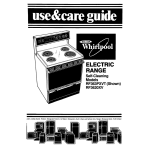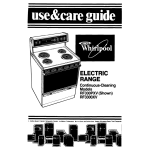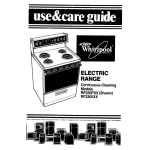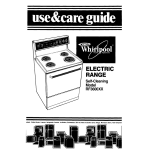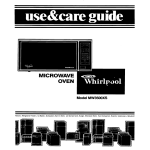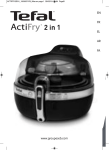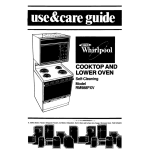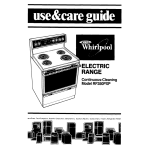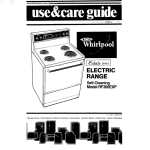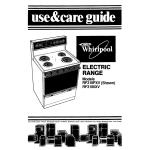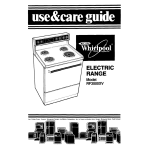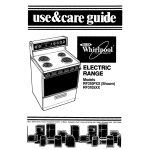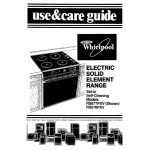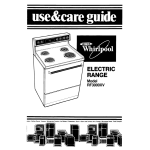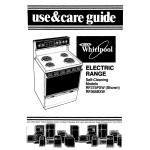Download Whirlpool RF363PXVT Specifications
Transcript
RANGE Self-Cleaning Models RF363PXW (Shown) RF3620XV Contents Page Page 3EFOREYOU USEYOUR RANGE. MPORTANT SAFETY INSTRUCTIONS. ............... PARTSAND FEATURES.......... JSING YOUR RANGE, .......... Using the Surface Units. ...... Home Canning Information .. Setting the Clock ............ Using the Minute Timer, ...... Baking or Roasting .......... Setting the Oven Controls .. How To Position Racks ............... andPans How To Use Aluminum Foil forBaking ............... Broiling ..................... Setting the Oven Controls Custom Broil .............. Broiling Tips ............... 2 3 5 6 6 8 Adjusting the Oven Temperature Control ...... Using the Automatic MEALTIMER’” Clock ........ TheOvenVent.. ............. The Storage Drawer ......... Optional Door Panel Pat .... 15 16 17 18 19 9 CARING FOR YOUR RANGE .... 19 9 10 10 Control Panel and Knobs .... Surface Units and Reflector Bowls ..................... Lift-Up Cooktop ............. Using the Self-Cleaning Cycle .................... Cleaning Chart ............. The Oven Light .............. 19 11 12 13 13 13 14 01990 Whirlpool IF YOU NEED SERVICE OR ASSISTANCE. .............. WHIRLPOOL RANGE WARRANTY ................... 20 22 23 26 27 28 32 Corporation Before you use your range You are responsible for: Reading and following all safety precautions in this Use and Care Guide. l Installing and leveling the range on a floor strong enough to support its weight, and where it is protected from the elements. (See the Installation Instructions.) l Making sure the range is not used by anyone unable to operate it properly. l Properly maintaining the range. . Using the range only for jobs expected of a home range. l Making sure the range is secured by a properly installed anti-tip bracket, with a rear leveling leg positioned under bracket. l Remove the Consumer Buy Guide label. It will be easier to remove before the range is used. To remove any remaining glue: l Rub briskly with thumb to make a ball, then remove. or l Soak area with liquid hand dishwashing detergent before removing glue as described above. Do not use sharp instruments, rubbing alcohol, flammable fluids orabrasive cleaners. These can damage the finish. See “Important Safety Instructions” on page 3. 2 IMPORTANT SAFETY INSTRUCTIONS To reduce the risk of fire, electrical shock, injury to persons, or damage when using the range, follow basic precautions, including the following: l l Read all instructions before using the range. Install or locate the range only in accordance with the provided Installation Instructions. It is recommended that the ran e be installed by a qualifie 8 installer. The range must be properly connetted to electrical supply and l gr;;unded. r@[ ;*I To reduce the riskof tipping of the appliance, the appliance must be secured by a properly installed anti-tip bracket. To check if the bracket is installed properly, remove the storage drawer (see page18 and verity that the antitip brat 1,et is engaged. l Do not use the range for warming or heating the room. Persons could be burned or injured, or a fire could start. l Do not leave children alone or unattended in area where the range is in use. They should never be allowed to sit or stand on any part of the range. They could be burned or injured. l Do not wear loose or hanging garments when using the range. They could ignite if they touch a hot surface unit or heating element and you could be burned. l Do not repair or replace any part of the range unless specifically recommended in this manual. All other servicin should be referred to a qualified 9echnician. l Do not store flammable materials in or near the range. They could explode or burn. . Do not use water on grease fires, l l l l l l Never pick up a flaming pan. Smother flamin pan on cooktop by covering wit 1 a well-fitted lid, cookie sheet or flat tray. Flaming grease outside of pan can be extinguished with baking soda or, if available, a multipurpose dry chemical or foam-type extinguisher. Use only dry potholders. Moist or damp potholders on hot surfaces may result in burns from steam. Do not let potholder touch hot heating elements. Do not use a towel or bulky cloth for a ,potholder. They could catch on fire. Select a pan with a flat bottom that is about the same size as the surface unit. If pan is smaller than the surface unit, some of the heating element will be exposed and may result in the igniting of clothing or potholders. Correct pan size also improves cooking efficiency. Never leave surface units unattended at high heat settings. A boil-over could result and cause smoking and greasy spill-overs that may ignite. Make sure the reflector bowls are in place during cooking. Cooking without reflector bowls may subject the wiring and components underneath them to damage. Do not line reflector bowls with aluminum foil or other liners. Improper installation of these liners may result in a risk of electric shock or fire. Check to be sure glass cooking utensils are safe for use on the cooktop. Only certain types of glass, glass-ceramic, ceramic, earthenware or other glazed utensils are suitable for cooktops without breaking due to the sudden change in temperature. continued on next page 1 Turn pan handles inward, but not over other surface units. This will help reduce the chance of burns, igniting of flammable materials, and spills due to bumping of the pan. ) Do not soak removable heating elements in water. The element will be damaged and shock or fire could result. ) Use care when opening oven door. Let hot air or steam escape before removing or replacing food. 1 Do not heat unopened containers. They could explode. The hot contents could cause burns and container particles could cause injury ) Keep range vents unobstructed. ) Always position oven racks in desired location while oven is cool. If rack must be moved while oven is hot, do not let potholder contact hot heating element in oven. ) Do not clean door seal. It is essential for a good seal. Care should be taken not to rub, damage, or move the seal. Clean only parts recommended in this Use and Care Guide. b Do not use oven cleaners. No commercial oven cleaner or oven liner protective coating of any kind should be used in or around any part of the oven. l l l Before self-cleaning the oven, remove broiler pan, broiler grid, oven racks and other utensils. Do not use your oven to clean miscellaneous parts. Do not store things children might want above the range. Children could be burned or Injured while climbing on it. Do not touch surface units, areas near units, heating elements or interior surfaces of oven. Surface units and heating elements may be hot even though they are dark in color. Areas near surface units and interior surfaces of an oven become hot enough to cause burns. During and after use, do not touch, or let clothing or other flammable materials contact surface units, areas near units, heating elements or interior surfaces of oven until they have had sufficient time to cool. Other surfaces of the range may become hot enough to cause burns; such as, the oven vent opening, the surface near the vent opening, the cooktop, the oven door and window. . FOR YOUR SAFETY. DO NOT STOREOR USEGASOLINE OR OTHER FLAMMABLE VAPORS AND LIQUIDS IN THE VICINITY OF THIS OR ANY OTHER APPLIANCE. THE FUMES CAN CREATE A FIRE HAZARD OR EXPLOSION. - SAVE THESEINSTRUCTIONS Thank you for buying a Whirlpool appliance. mail the Owner Registration Card provided complete the form below or call with a question. l l Have this information Copy model and serial numbers from plate (behind the oven door on the oven frame] and purchase date from sales slip. Keep this book and the sales slip together in a handy place. ready Serial Number Purchase Date Company and Then if you need service Model Number Service 4 Please complete with this product. Phone Number Parts and features Models RF363PXW and RF3620XV OVEN LIGHT \ SURFAC: UNIT INDICATOR LIGHT LEFT REAR CoNTRoL KNoB CONTROL PANEL \ OVEN TEMPERATURE INDICATOR / LOCKED INDICATOR LIGHT RIGHT FRONT CONTROL KNOB \ OVEN ON INDICATOR LIGHT LIGHT - / 8” OR 6” PLUG-IN SURFACE UNIT ONE PIECE CHROME REFLECTOR BOWL MODEL AND SERIAL NUMBER PLATE - GUIDE REMOVABLE STORAGE DRAWER _ [black front on RF363PXVT only) \’ (RF363PXV with wlndow) (RI Without window Using your range Using the Surface Units Surface Unit Indicator lights One of the surface unit indicator lights on the control panel will glow when a surface unit is on. Surface Unit Markers The solid dot in the surface unit marker shows which surface unit is turned on by that knob. Control knobs must be pushed in before turning them to a setting. They can be set anywhere and OFF. between HI Burn and Fire Hazard Be sure all control knobs are turned to OFF and all indicator lights are OFF when you are not cooking. Someone could be burned or a fire could start if a surface unit is accidentally left ON. Until you get used to the settings, use the following as a guide. For best results, start cooking at the high settings; then turn the control knob down to continue cooking. Turn on the surface unit only after placing filled pan on unit. Use HI to start Use MED-HI Use MED Use MED-LO Use LO to foods cooking; to bring liquids to a boil. to hold a rapid boil; to fry chicken or pancakes. for gravy, puddings and icing; to cook large amounts of vegetables. to keep food cooking after starting it on a higher setting. keep food warm until ready to serve. Set the heat higher or lower within the LO band to keep food at the temperature you want. Cookware There is no one brand of utensil that is best for all people. Knowing something about pan materials and construction will help you select the right cooking utensils for your needs. 1. Use only flat-bottomed utensils that make good contact with the surface units, To check the flatness of a utensil: l Turn it over and check the bottom of the pan by placing a ruler across it. l Rotate the ruler in all directions. There should be no gaps between the pan and the ruler. 6 2. The pan should have straight sides and a tight-fitting lid. 3. Choose medium to heavy gauge (thickness) pans that are fairly lightweight. Remember that a very heavy pan will be even heavier when filled with food. 4. The pan material (metal or glass] affects how fast heat transfers from the surface unit through the pan material and how evenly heat spreads over the pan bottom. 5. Handles securely l l l should be made of a sturdy, heat-resistant attached to the pan. material and be Burn, Personal Injury and Product Damage Hazard If the pan is too small for the surface unit, you could be burned by the heat from the exposed section of the surface unit. Use correctly sized cooking utensils to prevent injury. Not all glass, glass-ceramic, ceramic, earthenware and other glazed utensils are safe for cooktop cooking. Some will crack or break with sudden temperature changes, which could result in personal injury. If a surface unit stays red for a long time, the bottom of the pan is not flat enough or is too small for the surface unit. Prolonged usage of incorrect utensils for long periods of time can result in damage to the surface unit, cooktop, wiring and surrounding areas. To prevent damage, use correct utensils, start cooking on HI and turn control down to continue cooking. Do not leave an empty utensil, or one which has boiled dry, on a hot surface unit. It can overheat and may damage the utensil or surface unit. Do not use canners, woks and specialty utensils with rounded, warped, ridged or dented bottoms. These could cause severe overheating which damages the utensil and/or surface unit. Home Canning Information To Protect Your Range: 1. Use flat-bottomed canners for best results. Do not use canners with dented or ridged (porcelain enamel-ware] bottoms. They do not make good contact with the surface unit and cause severe over-heating which damages the cooktop. 2. For best results, use a canner which can be centered over the surface Large diameter canners, if not properly centered, trap heat and can cause damage to the cooktop. unit. 3. Do not place canner build-up will damage heat 4. Alternate batches. surface on two surface the cooktop. units at the same time. Excessive units. This allows the surface units to cool down between 5. Start with hot water. This reduces the time the control is set on high. Reduce heat setting to lowest position needed to keep water boiling. 6. Keep reflector bowls clean for best heat reflection. 7. To prolong the life of the elements: l Prepare small batches at a time. l Do not use elements for canning all day. Optional Canning Kit (Part NO. 242905) The large diameter of most water-bath or pressure canners combined with high heat settings for long periods of time can shorten the life of regular surface units and cause damage to the cooktop. If you plan to use the cooktop for canning, we recommend the installation of a Canning Kit. Order the kit from your Whirlpool dealer or authorized WhirlpoolSM service company. Setting the Clock Push in and turn the Minute Timer Knob to set the Clock. 1. Push in Minute turn clockwise Timer Knob and until clock the right time of day. shows 2. let the Minute Timer Knob pop out. Turn clockwise until Minute Timer hand points to OFF The clock setting will change if you push in the knob when turning. Using the Minute Tier The Minute Timer does not star-l or stop the oven. It works like a kitchen timer. Set it in minutes up to an hour. You will hear a buzzer when the set time is up. DO NOT PUSH IN THE KNOB when setting the Minute Timer. 1. Wlthout pushing it in, turn the Minute Timer Knob until the timer hand passes the setting you want. 2. Without pushing in, turn the knob back to the setting you want. When the time is up, a buzzer will sound. To stop the buzzer, turn the Minute Timer hand to OFF. PUSHING IN AND TURNING THE MINUTE TIMER KNOB CHANGES THE CLOCK SETTING. 9 Baking or Roasting Setting the Oven Controls I 1. Position the rack(s) properly before turning on the oven. To change rack position, lift rack at front and pull out. For information on positioning racks, see “How To Position Racks and Pans” on page 11. 3. Set the Oven Temperature Control to the baking temperature you want. The Oven HEATING Indicator Light will come on. The oven is preheated when the Oven HEATING Indicator Light first goes off. NOTE: Do not preheat roasting or cooking as casseroles, , 2. Set the Oven Selector on BAKE. The Oven ON Indicator Light will come on. 4. Put food in the oven. During baking, the elements will turn on and off to keep the oven temperature at the setting. The Oven HEATING Indicator Light will turn on and off with the elements. The top element helps heat during baking, but does not turn red. oven when items such 5. When baking is done, turn both the Oven Selector and Oven Temperature Control to OFF The Oven HEATING and ON Indicator Lights will go OFF 10 How To Position Racks and Pans The rack(s) should be placed so the top of the food will be centered in the oven. Always leave at least IM to 2 inches (4-5 cm) between the sides of the pan and the oven walls and other pans. For proper cooking, follow these guidelines l l l for specific foods: Angel and bundt cake pans, yeast breads, frozen pies, large roasts and turkeys - place rack on lowest level Casseroles, muffins, most quick breads and meats - place rack on second level from bottom Cookies, biscuits, cakes and non-frozen pies - place rack on second or third level from bottom When baking bottom. on two racks, arrange racks on bottom and third level from Fire and Personal Injury Hazard Always position oven racks in desired location before turning oven on. Be sure the racks are level. or oven mitts l If racks must be moved while oven is hot, use potholders to protect hands. or oven mitts contact hot heating elements. l Do not let potholders use a dry potholder or oven mitt to change racks or handle l Always utensils in the oven. Do not use a damp potholder or oven mitt. Steam burns could result. Failure to follow the above precautions may result in fire or personal injury. l The hot air must circulate around the pans in the oven for even heat to reach all parts of the oven. How to Use Aluminum Foil for Baking For Best Air Circulation: l l l Place the pans so that one is not directly over the other. Allow IYz-2 inches (4-5 cm) of space around each pan and between pans and oven walls. Use only one cookie sheet in the oven at one time. Use the following as a guide to determine where to place the pans. One Pan Place in the center of the oven rack. Use aluminum foil to catch spill-overs from pies or casseroles. l Place the foil on the oven rack below the rack with the food. The foil should have the edges turned up and be about 1 inch (3 cm) larger all around than the dish holding the food. l Do not cover the entire rack with aluminum foil. It will reduce air circulation and cause poor cooking results. Two Pans Place in opposite corners of the oven rack. NOTE: “Oven peeking” may cause heat loss, longer cooking times and unsatisfactory baking or roasting results. Rely on your timer. l l 12 Electrical Shock, Fire and Product Damage Hazard Do not allow foil to touch the heating elements because it will damage them and could result in shock or fire hazard. Do not line self-cleaning oven bottoms with foil or other liners. Poor baking will result. Damage to the oven finish will occur if left in oven during selfcleaning cycle. Broiling Setting the Oven Controls 1. Position the rack properly before turning on the oven. The oven rack should be positioned so that the surface of the food is at least 3 inches (7.4 cm] away from the broil element. 3. Close the door to the Broil Stop position [open about 4 inches, 10.2 cm). The door will stay open by itself. NOTE: The door must be partly open whenever the oven is set to BROIL. Leaving the door open allows the oven to maintain proper temperatures. Custom Broil l 2. Put the broiler the rack. pan and food on 4. Set the Oven Selector and Oven Temperature Control to BROIL. The Oven ON and HEATING Indicator Lights will come on. NOTE: Do not preheat oven when broiling. 5. When broiling is done, turn both the Oven Selector and Oven Temperature Control to OFF The Oven ON and HEATING Indicator Lights will go off. If food is cooking too fast, turn the Oven Temperature Control counteruntil the Oven Indicator Light goes off. If you want the food to broil slower from the start, set the Oven Temperature Control between150” and 325°F (65.5” and162.7”C). The lower the temperature, the slower the cooking. clockwise l The Oven Selector must be on BROIL for all broiling temperatures. 13 Broiling Tips l l l Use the broiler pan and grid for broiling. They liquid and fat away from the cooking surface or fire. Refer to a broiling chart in a reliable cookbook After broiling, remove the broiler pan from the food. Drippings will bake on the pan if it is left l l 14 are designed to drain excess to help prevent spatter, smoke for correct broiling times. oven when you remove the in the heated oven. Fire Hazard Place meat the correct distance from the element. Meat placed too close to the element may spatter, smoke, burn or catch fire during broiling. To ensure adequate grease drainage, do not use cookie sheets or similar pans for broiling. Also, covering the broiler grid with foil is not recommended. Poor drainage of grease may result in fire. If foil is used, cut slits in foil to correspond with all openings in broiler grid. Grease can then drain away and cool in pan. Adjusting the Oven Temperature Control Does your oven seem hotter or colder than your old oven? The temperature of your old oven may have shifted gradually without your noticing the change. Your new oven is properly adjusted to provide accurate temperatures. But whe compared to your old oven, the new design may give you different results. If after using the oven for a period of time, you are not satisfied with the temperature settings, they can be adjusted by following these steps: LOCKING 1. Pull the Oven Temperature Knob straight off. Control SCREWS 2. Loosen the locking screws inside the control knob. Note the posi- tion of the notches. NOiCHES 3. To lower TOdTH the temperature, move the tooth a notch closer to LO. Each notch equals about 10 ‘F (5°C). TO6TH NOiCHES 4. To raise the temperature, move the tooth a notch closer to HI. Each notch equals about 10°F (5°C). Tlghten the locking screws and replace the control knob. Using the Automatic MEALTIMER’” Clock The automatic MEALTIMER’” Clock is designed to turn the oven on and off at times you set, even when you are not around. Automatic baking is ideal for foods which do not require a preheated oven, such as meats and casseroles. Do not use the automatic cycle for cakes, cookies, etc.... undercooking will result. To delay start and stop automatically: 1. Position 2. Make sure the clock is set to the right time of day. I the oven rack(s) properly and place the food in the oven. 3. Push in and turn the Start Time Knob clockwise to the time you want baking to start. 1 4. Push in and turn the Stop Time Knob clockwise to the time you want the oven to shut off. I 5. Set the Oven Selector on TIMED BAKE. The Oven ON Indicator Light will come on. 6. Set the Oven Temperature Control on the baking temperature you want. The oven will now start and stop automatically. The Oven HEATING Indicator Light will come on. 7. After baking is done or to stop the oven before preset time, turn 16 both the Oven Selector and the Oven Temperature Control to OFF. To start baking now and stop automatically: 1. Position rack(s) properly and place the food in the oven. 2. Make sure the clock is set to the right time of day. 3. Push in and turn the Stop Time Knob clockwise to the time you want the oven to shut off. Make sure the Start Time Knob is out. 4. Set the Oven Selector on TIMED BAKE. 5. Set the Oven Temperature 6. Control on the baking temperature you want. After baking is done or to stop the oven before the preset time, turn both the Oven Selector and the Oven Temperature Control to OFF. To avoid sickness and food waste when using the MEALTIMER’” control: l Do not use foods that will spoil while waiting for cooking to start, such as dishes with milk or eggs, cream soups, and cooked meats or fish. Any food that has to wait for cooking to start should be very cold or frozen before it is put in the oven. MOST UNFROZENFOODS SHOULD NEVER STAND MORE THAN TWO HOURS BEFORECOOKING STARTS. l Do not use foods containing baking powder or yeast when using delay start. They will not rise properly. 9 Do not allow food to remain in oven for more than two hours after end of cooking cycle. The Oven Vent Hot air and moisture escape from the oven through a vent under the right rear surface unit. you can cook on the unit, or keep food warm on it while the oven is on. Burn Hazard If you leave a utensil on the right rear surface unit, use potholders when moving it. Pan handles can become hot enough to burn. Plastic utensils left over the vent can melt. The vent is needed for air circulation. Do not block the vent. Poor baking can result. The Storage Drawer The storage drawer is for storing pots and pans. The drawer can be removed to make it easier to clean under the range, and to check for installation of the anti-tip bracket. Use care when handling the drawer. Removing the storage drawer 1. Empty drawer of any pots and pans before removing drawer. Pull drawer straight out to the first stop. Lift front and pull out to the second stop. Replacing the storage drawer 1. Fit ends of drawer the drawer of opening. 2. Lift back slightly and slide drawer all the way out. guides slide rails into on both sides 2. Lift drawer front and push in until metal stops on drawer slide rails clear white stops on drawer guides. Lift drawer front again to clear second stop and slide drawer closed. To verity the anti-tip is engaged: Remove the storage drawer. Look to see if the anti-tip bracket is attached to floor with screws. l Make sure one rear leveling leg is positioned under the anti-tip bracket. . See Installation Instructions for further details. l l 18 bracket Optional Door Panel Pat (Model RF’363PXVT only) If you would like to change the color of your oven door glass to white or almond, you can order one of these kits: White (Kit No. 814069) or Almond (Kit No. 814070) from your Whirlpool Dealer. The kits include easy installation instructions. Caring for your range Control Panel and Knobs Burn and Electrical Shock Hazard Make sure all controls are OFF and the range is cool before cleaning. Failure to do so can result in burns or electrical shock. 1. Turn control knobs to the OFF position. 2. Pull control knobs straight off. 3. Use warm soapy water or spray glass cleaner, control panel. Rinse and wipe dry. 4. Wash control 5. Replace knobs in warm soapy control knobs by pushing and a soft cloth, to wipe the water. Rinse well and dry. Do not soak. them firmly into place. NOTE: When cleaning, never use steel wool, abrasives, cleaners which may damage the finish. After cleaning, knobs point to the OFF position. or commercial oven make sure all control Surface Units and Reflector Bowls Removing Burn and Electrical Shock Hazard Make sure all surface units are OFF before removing surface units and reflector bowls. Failure to do so can result in burns or electrical shock. I 1. Turn off all surface units 3. Pull the surface unit straight from the receptacle. 20 2. Lift the edge of the unit, opposite the receptacle, just enough to clear the element hold down clip and the reflector bowl away 4. Lift out the reflector bowl. See “Cleaning Chart” on page 26 for cleaning instructions. Replacing Burn, Electrical Shock and Fire Hazard Make sure ail surface units are OFF before replacing surface units and reflector bowls. Failure to do so can result in burns or electrical shock. Do not line the reflector bowls with foil. Fire or electrical shock could result. l l 1. Turn off att surface units. 2. Line up openings in the reflector bowl with the surface unit receptacle and the element hold down clip. I . Hold the surface unit as level as possible with the terminal just started into the receptacle. Push the surface unit terminal into the receptacle. I 4. When terminal is pushed into the receptacle as far as it will go, push down the edge of the surface unit opposite the receptacle. The element hold down clip will keep the surface unit from moving around. NOTE: Reflector bowls reflect heat back to the utensils on the surface units. They also help catch spills. When they are kept clean, they reflect heat better and look new longer. If a reflector bowl gets discolored, some of the utensils may not be fiat enough, or some may be too large for the surface unit. In either case, some of the heat that’s meant to go into or around a utensil goes down and heats the reflector bowl. This extra heat can discolor it. 21 Lift-Up Cooktop 1. Lift front of cooktop at both front corners until the support rods lock into place. Personal Injury and Product Damage Hazard . Be sure both support rods are fully extended and in the locked position. Failure to do so could result in personal injury from the cooktop accidentally falling. l Do not drop the cooktop. Damage can result to the porcelain and the cooktop frame. 22 2. Wipe with warm, soapy water. Use a soapy steel wool pad on heavily soiled areas. 3. To lower the cooktop, lift cooktop from both sides while pressing the support rods back to unlock them. Lower the cooktop into place. Using the Self-Cleaning Cycle The Self-Cleaning cycle uses very high heat to burn away soil. Before you start, make sure you understand exactly how to use the Self-Cleaning cycle safely. Before You Start 1. Clean the areas shown by hand. They do not get hot enough during the Self-Cleaning cycle for soil to burn away. Use hot water and detergent or a soapy steel wool pad on... l The inside of the door. (The center area of the door does not need to be hand cleaned.) l The frame around the oven. DO NOT clean, move or bend the fiberglass seal. Poor cleaning and poor baking will result. 2. Remove the broiler pan and any pots and pans you may have stored in the oven. NOTE: The broiler pan (without grid] can be cleaned in the oven only if most of the soil has been removed by hand-cleaning or a dishwasher. The chrome broiler grid will discolor if cleaned in the Self-Cleaning cycle. 3. Wipe out any loose soil or grease. This will help reduce smoke during cycle. the Self-Cleaning 4. If you want the oven racks to remain shiny, remove from the oven and clean by hand. Otherwise, put oven racks on second and fourth guides (guides are counted from bottom to top]. After racks are cleaned in the Self-Cleaning cycle, they become harder to slide. Apply a small amount of vegetable oil to the sides of the racks to make them easier to slide. See chart on page 26. Chrome reflector bowls must NOT not be cleaned in the oven. They SEAL will discolor. HAND CLEANFRAME HAND CLEAN DOOR AROUND EDGE Turn on the vent hood or other kitchen vent during the Self-Cleaning cycle. This will help remove heat and odors that are normal during the cycle. Personal Injury and Product Damage Hazard Do not touch the oven during the Self-Cleaning cycle. It could burn you. l Do not use commercial oven cleaners in your oven. Cleaners may produce hazardous fumes or damage the porcelain finish. l Do not force the lock lever, you could bend or break it. The lever is designed to stay locked until the oven is cool enough to safely open. Wait until it moves freely. . Do not use foil or other liners in the oven. During the Self-Cleaning cycle foil can burn or melt and damage the oven surface. 9 Do not block the vent during the Self-Cleaning cycle. Air must move freely for best cleaning results. l Do not leave plastic utensils near the vent. They may melt. l Setting the Controls Be sure the kitchen is ventilated during the Self-Cleaning cycle. This will help heat, odors and smoke to dlsappear from the room as quickly as possible. 1 1 1 1. Set the 2. Make sure the Clock, Start and Stop Times all have the right time of day. Oven Selector and Oven Temperature Control on CLEAN. I 3. Push in and turn the Stop Time Knob clockwise 2 or 3 hours. l Use 2 hours for light soil. l Use 3 hours or more for moderate to heavy soil. NOTE: Make sure the Start Time Knob is out. 4. Move the Lock Lever to the right the Clean position. The Oven HEATING and ON Indicator Lights will come on. 6. After the Self-Cleaning cycle is completed, the Oven LOCKED I. 5. The Oven LOCKED Indicator Light comes on when the oven temperature exceeds normal baking temperatures. The Lock Lever must not be moved and the door can’t be opened when the Oven LOCKED Indicator Light is on. 24 I Indicator Light goes off when the oven reaches normal baking temperatures. Move the Lock Lever back to the left. Do not force it. Wait until it moves easily. Turn the Oven Selector and Oven Temperature Control to OFF. 7. After the oven is cool, wipe off any residue or ash with a damp cloth. If needed, touch up spots with a soapy steel wool pad. Special Tips l l l Keep the kitchen well ventilated during the Self-Cleaning cycle to help get rid of heat, odors and smoke. Clean the oven before it gets heavily soiled. Cleaning a very soiled oven takes longer and results in more smoke than usual. If the Self-Cleaning cycle doesn’t get the oven as clean as you expected, the cycle may not have been set long enough or you may not have prepared the oven properly. Set the Self-Cleaning cycle longer the next time and hand clean areas noted on page 23. To stop the Self-Cleaning anytime: cycle at 2. Turn the Oven Selector and Oven Temperature Control to OFF. When the Oven LOCKED Indicator Light goes off, move the Lock Lever back to the left. DO NOT FORCE IT. Wait until it moves easily. 1. Push in and turn the Stop Time Knob clockwise until it points to the right time of day. How It Works During the Self-Cleaning cycle, the oven gets much hotter than it does for baking or broiling...approximately 875°F (468°C). This heat breaks up grease and soil and burns it off. This graph shows approximate temperatures and times during a SelfCleaning cycle for 3 hours. SELF-CLEANING CYCLE -THREE HOUR SEITING (Approximate 1000°F I A 875°F I 800°F Temperatures (468’C) I and limes) CLEANING I 1I CYCLE I L I I I I 538°C I 427°C 600°F 316°C 400°F 204°C 200°F 93°C STAR1 Yzhr. 1 hr. 1 b hrs. 2 hrs. 2 h hrs 3 hrs. 3 62 hrs STOP Notice that the heating stops when the 3-hour setting is up, but that it ta kes longer for the oven to cool down enough to unlock. 25 Cleaning Chart HOW TO CLEAN PART WHAT TO USE Exterior surfaces (porcelain and chrome tlnlsh) Wipe off regularly when range is cool. l Apply non-abraslve cleaner with damp sponge and rinse well. Do not use abrarlve or harsh cleansers. l Do not allow food contalnlng acids (such as vinegar, tomato, lemon Juice or milk) to remain on surtace. Acids may remove the glossy tlnlsh. l Make sure cooktop is COOL. l Follow directions provided with cleaner or polishing creme. NOTE: For chrome surfaces, follow above cleaning InStNCtlOnS before uslng non-abrasive chrome cleaner or Cook Top Pollshlng Creme (Part No. 814009). (chrome tlnlsh) Surtace unlts Warm soapy water and a soft cloth. Non-abrasive plastic scrubbing pad or non-abrasive cleaner for heavily-soiled areas. No cleaning required. l l l Chrome retlector bowls Warm soapy water and a non-abrasive plastic scrubbing pad. l l l l Control Control knobs panel Broller pan and grld Oven racks Oven door glass Self-Cleaning Oven 26 Warm soapy a soli cloth. water and l l Spatters or spills will burn off Do not Immerse in water. Wash, rinse and dry well. Clean frequently. Do not use abrasive or harsh cleansers. Do not clean in Self-Cleaning Oven. Wash, rinse and dry well. Do not soak. Wash, rinse and dry well. Follow directions provided with the cleaner. l Clean after each use. Warm soapy water or a . Wash, rinse and dry well. soapy steel wool pad. l Do not clean In SelfCleanIng Oven. (See note on page 23.) l Leave in oven during Self-Cleaning Self-Cleaning cycle. cycle. OR Warm soapy water or l Wash, rinse and dry. Use soapy steel soapy steel wool pads. wool pads for heavily-soiled areas. NOTE:The oven racks will discolor and be harder to slide when lett In the oven durlng the Self-Cleaning cycle. It you want them to stay shiny, remove trom the oven and clean by hand. l Make sure oven is cool. Spray glass cleaner or warm soapy water and l Follow directions provided with a non-abrasive plastic the cleaner. scrubbing pad. l Wash, rinse and dry well. l Follow directions starting on For areas outside the Self-Cleaning area use page 23, “Using the Self-Cleaning Cycle:’ warm soapy water or soapy steel wool pads. . Do not use commercial oven cleaners. l Do not use toll to llne the bottom of your SelfCleanIng Oven. Warm soapy water spray glass cleaner and a soft cloth. or l l The Oven Light lightwill come on when you push the Oven Light Switch on the control panel. Push it again to turn off the light. Model RF3620XV: The oven light will come on when you open the oven door. Model RF363PXVT: The oven To Replace : l l Electrlcal Shock and Personal Injury Hazard Make sure oven and light bulb are cool and power to the range has been turned OFF before replacing the light bulb. Failure to do so could result in electrical shock or burns. The bulb cover must be in place when using the oven. The cover protects the bulb from breaking, and from high oven temperatures. Since bulb cover is made of glass, be careful not to drop it. Broken glass could cause injury. 1. Unplug appliance at the main power or disconnect supply 3. Remove the light bulb from its socket. Replace the bulb with a 40-watt appliance bulb. 2. Remove the glass bulb cover in the back of the oven by screwing it out counterclockwise. 4. Replace the bulb cover by screwing it in clockwise. Plug in appliance or reconnect at the main power supply. NOTE:The oven light will not work during the Self-Cleaning cycle. If you need service or assistance, we suggest you follow these steps: 1. Before calling for assistance... Performance problems often result from little things you can find and fix without tools of any kind. If nothing operates: Is the into a age? Have main l l power supply cord plugged live circuit with the proper volt(See Installation Instructions.) you checked your home’s fuses or circuit breaker box? If the oven will not operate: Is the Oven Selector turned to BAKE or BROIL? If Oven Selector is turned to TIMED BAKE, wait until the start time is reached. Is the Oven Temperature Control turned to a temperature setting? Is the automatic MEALTIMER’” Clock set correctly? l l l If surface units will not operate: Have you checked your home’s main fuses or circuit breaker box? . Are surface units plugged in all the way? . Do the control knobs turn? l If surface not turn: unit control knob(s) will Did you push in before trying to turn? l If the Self-Cleaning operate: cycle will not Are the Oven Selector and Oven Temperature Control set on CLEAN? Does the Start Time Dial show the correct time of day? Is the knob all the way out? Is the Stop Time Dial set ahead to the time you want the cleaning cycle to stop? Is the Lock Lever all the way to the right? l l l l If cooking expected: l Is the range 28 results aren’t what you level? Does the oven temperature seem too low or too high? See page 15. l If needed, have you preheated the oven as the recipe calls for? . Are you following a tested recipe from a reliable source? l Are you using pans recommended in the “Cookware” section on page 6? l If baking, have you allowed IM to 2 inches (4-5 cm) on all sides of the pans for air circulation? l Are the pans the size called for in the recipe? l Do the cooking utensils have smooth, flat bottoms and fit the surface elements being used? l 2. If you need assistance%. Call Whirlpool COOL-LINE” service assistance telephone number. Dial free from anywhere in the U.S.: l-800-253-1301 and talk with one of our trained consultants. The consultant can instruct you in how to obtain satisfactory operation from your appliance or, if service is necessary, recommend a qualified service company in your area. If you prefer, write to: Mr. Donald Skinner Director of Consumer Relations Whirlpool Corporation 2000 M-63 Benton Harbor, Ml 49022 Please include a daytime phone number in your correspondence. 3. If you need service?.. Whirlpool has a 5. If you are not satisfied with how the problem was solved%.. l service companies. Whirlpool service technicians are trained to fulfill the product warrantv and provide after-warranty service, anywhere in the United States. To locate the authorized Whirlpool service company in your area, call our COOL-LINE@ service assistance telephone number (see Step 2) or look in your telephone directory Yellow Pages under: l l WHlRLPOOL SERVICE A”THORlZE0 SERVICE (‘O.WP.4.VIE.s XYZ SERWE co 123MAru 999-9999 4. If you need FSP” replacement parts%. FSP is a registered trademark of Whirlpool Corporation for quality parts. Look for this symbol of quality whenever you need a replacement part for your Whirlpool appliance. FSP replacement parts will fit right and work right, because they are made to the same exacting specifications used to build every new Whirlpool appliance. To locate FSP replacement parts in yourarea, referto Step 3aboveorcaII the Whirlpool COOL-LINE service assistance number in Step 2, Contact the Major Appliance Consumer Action Panel (MACAP). MACAP is a group of independent consumer experts that voices consumer views at the highest levels of the major appliance industry. Contact MACAP only when the dealer, authorized servicer or Whirlpool have failed to resolve your problem. Major Appliance Consumer Action Panel 20 North Wacker Drive Chicago, IL 60606 MACAP will in turn inform us of your action. *When requesting assistance, please provide: model number, serial number, date of purchase, and a complete description of the problem. This information is needed in order to better respond to your request. Notes 30 Notes WHIRLPOOL’ RANGE PRODUCT WARRANTY 1 WHIRLPOOL 1 LENGTH OF WARRANTY FSP* replacement parts and repair labor to correct defects in materials or workmanship. Service must be provided by an authorized WhirlooolSM service comoanv. FULL ONE-YEAR WARRANTY From Date of Purchase WHIRLPOOL EROOl WILL PAY FOR WILL NOT PAY FOR A. Service calls to: 1. Correct the installation of the range product. 2. Instruct you how to use the range product. 3. Replace house fuses or correct house wiring or plumbing. 4. Replace owner accessible light bulbs. B. Repairs when range product is used in other than normal, single-family household use. C. Pick up and delivery. This product is designed to be repaired in the home. D. Damage to range product caused by accident, misuse, fire, flood, acts of God or use of products not approved by Whirlpool. WHIRLPOOL CORPORATION SHALL NOT BE LIABLE FOR INCIDENTAL OR CONSEQUENTIAL DAMAGES. Some states do not allow the exclusion or limitation of incidental or consequential damages so this limitation or exclusion may not apply to you. This warranty gives you specific legal rights, and you may also have other rights which vary from state to state Outside the United States, a different warranty may also apply. For details, please contact your franchised Whirlpool distributor or military exchange. If you need service, first see the “Service and Assistance” section of this book. After checking “Service and Assistance:’ additional help can be found by calling our COOL-LINE* service assistance telephone number, l-800-253-1301, from anywhere in the U.S. @Registered Trademark/TM Trademark/SM Service Mark of Whirlpool Part No. 3150571 01990 Whirlpool Corporation ce Makers. DIshwashers. Eull-In Ovens and Surlace Umls Ranges. Microwave Corporation Printed in U.S.A. Ovens. Trash Compaclors Room Au Condllwws Oehumldlllen. Automat
































